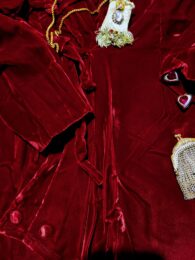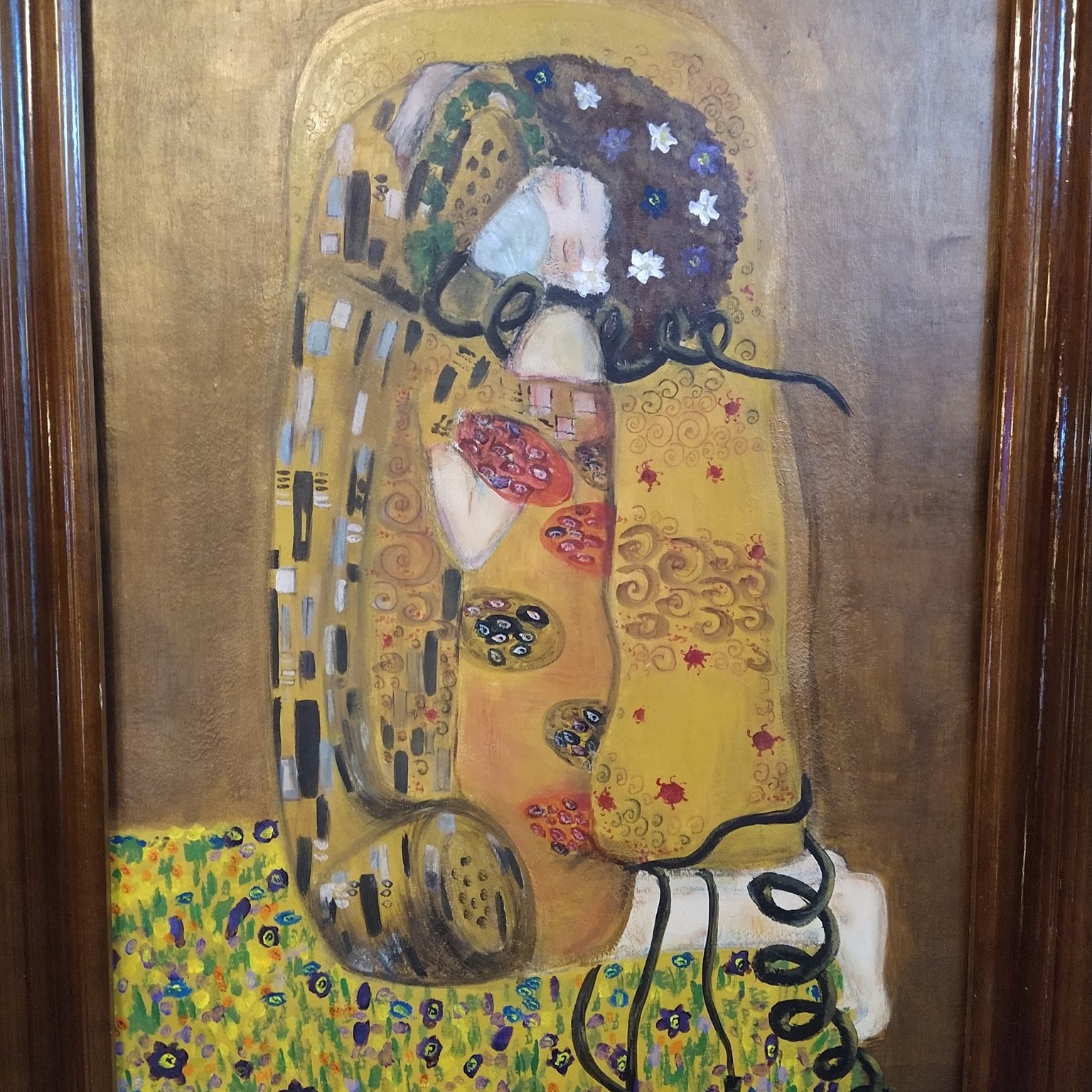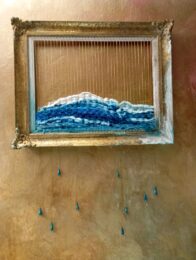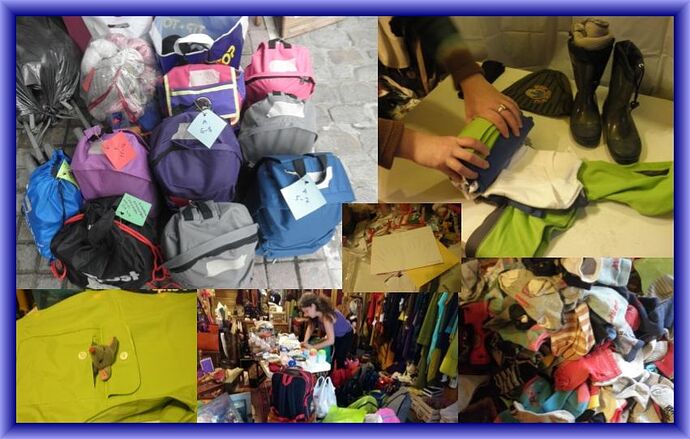Featured Articles
Backpacks for the Refugees-The Day After
Summer 2015. It was nearly the end of August when Kos Island turned into a battlefield during a registration procedure. Hundreds of protesting migrants demanding quick registration began blocking the main coastal road. The local police attempted to break up the crowd with batons and by spraying foam with fire extinguishers. An officer was being filmed slapping and shoving migrants queueing outside the local police station.
My grandmother came to mind and her story as a refugee child from the area of Pontos (Northern Turkey) in 1922. I just couldn’t believe that something like that could happen again. Despite the fact that Greece, in the throes of its worst ever financial crisis, was straining to accommodate the inflow, most Greek islanders were doing their best. But still there was an ominous feeling in the air.
And then I saw that photo. A young woman with her two frightened children hanging onto her arms. Walking to nowhere, barefoot. Beyond endurance, angry but determined to survive the crush. Fearless, though! Imperious! I got angry. I stood beside her, out there in the dust. I’m just one step away from being like her.
That moment I realized that there isn’t any Deus ex Machina to save them. To save us.
So, I started thinking… What would I need if I were there? What should I carry to help my children withstand it? What should I bring with me for a little break? …and their feet! What will happen to their feet? And the sun? It’s hard being a parent in peace. In war and in refuge, only a hero.
I wrote a list* with the necessities. The obvious, the necessary, even those things that seemed unnecessary. The goal was to ease the burden of parents, to give a smile to children. A breath until the next aid. A hope…
I post the list in my private facebook profile. I couldn’t imagine the impact of this simple action. In a few days people were coming to my place, bringing bags full of nearly everything! Friends, neighbors or strangers were coming to help. We‘ve been preparing backpacks and sending them to Idomeni, to the islands or anywhere they were needed. Many schools adopted the idea and soon the campaign went viral. In around 8 months, hundreds of people became mobilized and focused on helping this endless wave.
It seems that we could tell a lot of stories about, and because of this, but the point now is what emerged from this need. There’s a lot of information coming out in the aftermath of this experience.
There’s a mountain of questions that we didn’t answer…
Is there any kind of system in the world that could cope with that amount of people?
What was wrong and why didn’t anyone know how to react or to organize?
Why weren’t we ready? Why didn’t governments, NGO’s and independent groups cooperate? And when they did, what happened?
What socks are most appropriate for their long trek?
How can we fit all the necessary items in a backpack?
And what about the weight?
How can we gather the right clothing from the world?
Have you ever try to sort thousands of clothes?
Is it true that women from Syria didn’t want to wear rain boots?
And what about UNHCR’s wool blanket?
And all those tons of food wrappers, wet wipes, bottles…?
Sadly, it turns out that there was no rescue plan in place. Greece seems to be inefficient and Europe appears like an impregnable fortress. This brings up the question “What if a sudden disaster left millions of Greeks or other Europeans homeless and helpless?”
Local authorities and their services operated superficially while the government was obviously unprepared. On the other hand, citizens reacted vigorously and passionately despite the fact that they didn’t mobilize immediately.
It’s also notable that many conferences, workshops or unofficial brainstorming meetings took place and new technology-oriented groups were created. New ideas and solutions were proposed and innovative applications were developed from people all over the world. However, most of those didn’t fall on fertile ground for wide use, thus must be investigated thoroughly in the future.
Due to my profession as a fashion designer and manufacturer, when I heard about all those calls for clothing needs I started wondering who will manage all these diverse supplies. When facing a disaster, food and medical aid are considered top priorities but it’s not widely known that wearing inappropriate clothing under extreme conditions can become life threatening.
It’s noteworthy that if we focus on specific issues we can come to interesting conclusions e.g. Public misinformation by “official” announcements that were based on internet searching or common knowledge about clothing. As a result, there was a shortage of A-shirts (tank tops) while, considered useless, thousands of used socks were gathered although it costs less to buy new ones. Also, acrylic socks were suggested as the most appropriate. But when there’s no luxury of changing them anytime, other materials are more suitable like; wool, bamboo, cotton, tactel etc.
Obviously, a problem, arisen from common everyday items, is more complicated than initially thought and requires an expert’s opinion.
So, without surprise, no one reached out to experts from the clothing sector for professional advice and assistance. Moreover both government and UNHCR ignored any proposals or contact efforts.
Surely, the day after was going to be a nightmare. Inexperienced volunteers struggled to adequately classify, pack and distribute huge amounts of donations. Very often the same material had to be sorted again and again for multiple times. The inadequate coordination among government authorities, NGOs, solidarity groups and other stakeholders in combination with the anxiety of refugees led to a disappointing result. Large amounts of food, clothing, medicines and a lot of useless things (that could be a separate funny story), were being carried around Greece like a giant pinball machine. Unnecessary shipments, aid wasted, corrupted by mold, insects or still remain in inappropriate warehouses. A serious waste of resources.
In conclusion, the refugee crisis gave rise to a strong solidarity network and also an opportunity for local communities and the society in total. An innovative strategic plan seems to be a necessity, in order to coordinate and manage all the available resources successfully.
We should focus on organizing and training ourselves for cases of emergency. Based on the strength of these sharing communities, we should work, in innovative ways, which could bring people together around common concerns, recognize and increase their skills and knowledge and instill in them a belief that they can make a difference.
In addition, it’s important to develop a survival handbook with the aim to provide “how-to” guidance based on practical experience in combination with academic knowledge. And the challenge is to respond to all these arisen questions. Or add new.
“Could humanitarianism be evolved as a profession or it could be a new way of living?”
P. S.
More than 1/5 of donations is unsuitable for the refugees, thus is channeled to other vulnerable groups directly or in cooperation with already existing structures.
Most of the volunteers gave up, burned out or feeling unable to help. Meanwhile the main responsible for this failure get paid.
More than 60.000 refugees stuck in Greece. The majority were transferred to military camps, old factory warehouses or other abandoned and unhealthy places. Out of sight, out of mind. Lost and forgotten.
*The winter list for children: Small backpack, waterproof poncho, aluminum blanket, flashlight, socks, rain boots, sports shoes or plastic clogs, underwear, a tracksuit or a change of clothes, cap, gloves, scarves, lunch box, plastic spoon, fork, knife, a bottle of water, cookies, nuts, dried fruit or other snacks, wet wipes (small package), tissues, toothbrush, samples (of sunscreen, shampoo, toothpaste etc.), a toy, note or drawing pads, crayons, pencil, sharpener, eraser, a whistle and a wish (!!) (We also ask for big scarves to use them as ring sling baby carriers or as sheets)
The production of this article was supported by Op3n Fellowships – an ongoing program for community contributors during May – November 2016.
Σύντομο βίντεο ετοιμασίας των σακιδίων:
Αραβέλλα Σαλονικίδου | | Featured Articles, Σακίδια Προσφύγων-Backpacks for the Refugees 2015-2016 | 0 Σχόλια
COSMUS (diy) – One to One: Donating backpacks full of care
In August 2015, as the first large waves of refugees started landing on the Greek shores and stuck along the border of Idomeni, I started this initiative of collecting and filling backpacks with first need items for refugees. At first, this has started very modestly, with a few friends organizing clothing donations through Facebook. At the beginning, I wasn’t expending such a big response to my call, but volunteers -known and unknown- started visiting my clothing shop in Thessaloniki, bringing clothes and helping out to fill in the backpacks.Within two months, this action spread virally all over Greece. Over time, I networked with other grassroots initiatives active in refugee care, such as the Alternative Immigrant Centre of Thessaloniki (@To-Steki) and Oikopolis. In some cases, people followed our instructions and respected our philosophy of unconditional giving, but there have also been problematic cases because there were also people that tried to hijack the process for personal gain.
I have learned to live with the dynamics, and I started helping out at Oikopolis, to create a clothing storage, explaining an internationally used methodology of inventorying, so refugees were able to serve themselves on their own. This system still works, where refugees can come, try and take the clothes they need for free.
While continuing to work with clothes, I now focus on providing school items for children and the campaign has shifted focus. From just catering for refugees, we also provide care for native homeless people. Through a Facebook page https://www.facebook.com/groups/519478964902645/ 2, we are trying to organize volunteers who adopt the schooling needs/items of children in need. These needs may be covered through a donation of items or money, and this is open to everyone. So far, the stock gathered so far through donations, is enough for about 250 kids. In parallel, I am organizing seminars and crash courses on repairing clothes and upcycling old objects to create, for example, pencil boxes.
There is another task, which is more time-consuming and complex, in terms of research. I’m in the team-building process that will eventually become a non-profit legal entity, to develop a Handbook for the Management of Material and Resources, in cases of emergency. For example, due to my professional background, I know how to sort and store thousands of clothing items. Somebody else might have other skills. This is also connected with the sharing of knowledge of alternative treatments, practices or hacks, that might offer cheap and practical solutions to people in need. For example, using cocoa powder as a shampoo, or other uses of baking soda, salt, etc.
I come from Thessaloniki, and my ancestors were refugees. Initially, the response from my immediate environment has been disappointing. My job is in the clothing sector, however, being an elected Municipal Councillor at the City of Thessaloniki, people know my public activity so it was easy to build trust. Furthermore, I am sitting at the Management Board to the Municipal TV100 station. Having many contacts with journalists helped to communicate the action widely. All this combined has resulted in the massive spontaneous response of a community of 1500 citizens from all walks of life. Including people from Europe and the US, who donated waterproof jackets and blankets.
As s municipal councilor, I am in contact with local authorities. Sadly the Municipality responded very poorly, compared to what it could do. Same goes with the Ministry of Immigration Policy. We talked to the consultants, they appreciated our effort, but there was no practical result.
Unfortunately, the public sentiment is negative. Mass media shape the opinion that the refugees stopped crossing borders, so people believe that they stopped coming. Others falsely believe that refugees are to blame for anything wrong. And since the beginning of the summer, most volunteers disappeared. This has, inevitably, resulted in a fatigue in the area of refugee care.
Nevertheless, I have no other option but continue. I wish to launch a crowdsourcing campaign, so the venture can continue. I imagine of a list of people with different skills, who -in the case of need- will be ready to take up a certain role. A type of inventory of what human assets exist and what everyone can contribute.
Αραβέλλα Σαλονικίδου | | Featured Articles, Σακίδια Προσφύγων-Backpacks for the Refugees 2015-2016 | 0 Σχόλια
Κόκκινο Βελούδο
Βαθύ κόκκινο. Όπως μόνο το βελούδο μπορεί. Ένα φόρεμα κοκτέιλ από βαθυκόκκινο σιφόν με ντυμένα κουμπιά κι ανοιχτό ντεκολτέ. Το βγάζω από τη θήκη προσεκτικά. Πάνε δεκαετίες πλέον…. Νομίζω πως το έραψα για ένα γάμο, ή μήπως για ένα ρεβεγιόν; Ρεβεγιόν; Τι φάση κι αυτή! Το κρατάω μπροστά μου με την κρεμάστρα. Το άλλο χέρι στη μέση, όπως αρμόζει απέναντι στον καθρέφτη. Αυτός αμείλικτος, με παρατηρεί εξονυχιστικά. Δε βγάζει μιλιά. Είναι πολύ παλιός, ξέρει πότε να σωπαίνει…. Χαϊδεύω μηχανικά την πλαϊνή ραφή, προχωράω στο στήθος. Σκαλώνω στα κουμπιά, μπαίνω στις πτυχώσεις. Το μυρίζω. Ψάχνω για μια υποψία μυρωδιάς. Τίποτε. Χωρίς άρωμα, χωρίς ιδρώτα. Είναι ένα ξένο ρούχο πια. Απάνθρωπο…
Ξανακοιτάζω στον καθρέφτη. Εμένα, το φόρεμα. Περνάω στην άλλη πλευρά, είμαι εκείνη που το φορούσε. Λάμπω! Είμαι σε μια φωτογραφία με κατακόκκινα χείλη. Γελάω, ενώ κάποιος μου ψιθυρίζει στο αυτί ένα μυστικό. Τι ήταν άραγε; Έχω θάψει όλα τα μυστικά τόσο βαθιά που χάθηκαν. Με κατάπιαν κι εμένα. Το κόκκινο φόρεμα πέφτει αναπάντεχα στο πάτωμα κενό. Σαν κηλίδα από αίμα. Είμαι απέναντι απ’ τον καθρέφτη γυμνή. Καινούργια, χωρίς παρελθόν. Δεν την γνωρίζω αυτήν που φορούσε αυτό το φόρεμα. Ούτε αυτήν, ούτε τα μυστικά της. Σκύβω να σηκώσω το φόρεμα, αλλά δε μπορώ. Γυρίζουν πίσω τα χέρια μου άδεια. Γονατίζω, αλλά ούτε και τώρα μπορώ. Είναι πολύ βαθύ το κόκκινο. Ξύνω με τα νύχια μου το πάτωμα. Ματώνω. Έπρεπε να ήμουν εκεί, μέσα στο φόρεμα, με το λαμπερό χαμόγελο και τα παράξενα παπούτσια. Κοιτάζω τα ακροδάχτυλα των ποδιών μου, ασπρίζουν έχοντας αδράξει το πάτωμα γερά. Δε μπορώ πια να πάω πουθενά. Έχω εγκλωβιστεί στο παρόν. Γυμνή, χωρίς μυστικά, ξυπόλυτη. Με ένα ιδιότροπο κόκκινο φόρεμα που κρέμεται τριάντα χρόνια στη ντουλάπα με γυρισμένη την πλάτη. Που αρνείται να με κοιτάξει. Τέλειο, άοσμο, ανέπαφο. Με το ντεκολτέ να με χλευάζει. Κι έχουμε περάσει τόσα μαζί…
Ρίχνω μια βιαστική ματιά στον καθρέφτη. Δείχνω πολύ αυστηρή. Καλά θα κάνει να σωπάσει για πάντα. Ό,τι συμβαίνει πρέπει να μείνει αναμεταξύ μας. Ανοίγω το συρτάρι και βγάζω το παλιό ραφτάδικο ψαλίδι μου. Είναι θαυμαστό εργαλείο το ψαλίδι. Δημιουργός και καταστροφέας ταυτόχρονα. Ψαλιδίζω δοκιμαστικά στον αέρα. Οι λάμες ακούγονται ετοιμοπόλεμες. Πλησιάζω το κόκκινο φόρεμα που είναι ακόμη πεσμένο στο πάτωμα. Το ισιώνω, διορθώνω τα μανίκια, το περιεργάζομαι ξανά απ’ την αρχή. Κάθομαι στο πάτωμα δίπλα του, με το ψαλίδι στο χέρι.
Χαμογελάω. Κόβω προσεκτικά μια κλωστούλα που ξέφυγε απ’ το στρίφωμα. Είναι το φόρεμα της νιότης μου. Το αγαπώ.
Αραβέλλα Σαλονικίδου | | Featured Articles, Καλώς ή Κακώς Κείμενα, Πεζά, Ποιήματα, Παραμιλητά, Παραμύθια... | 1 Σχόλιο
Σα βγω απ’ αυτή τη φυλακή…*
…το δέρμα μου λευκό και τρυφερό, θα ριγεί σε κάθε άγγιγμά σου. Θα κατεβάζεις τη μάσκα μου με τ’ ακροδάχτυλα, αναζητώντας τα χείλη μου, με έναν ακαθόριστο φόβο… Μήπως δεν είμαι εκεί. Θα είμαι. Θα φοβάμαι λίγο τον ήλιο και θα δακρύζουν τα μάτια μου για κάτι άλλο, αλλά εγώ θα επιμένω ότι φταίει το φως. Θα παριστάνεις ότι με πιστεύεις για να μη λυγίσουμε. Θα με πιάσεις απ’ το μπράτσο, όπως τότε που νόμιζα ότι θα σε εγκατέλειπα ή το αντίθετο. Θα με πιάσεις απ’ το μπράτσο, σφιχτά, για να μην χαθούμε στην ομίχλη. Ή μήπως δεν έχει ομίχλη; Θα με κρατήσεις σφιχτά δίπλα σου. Έχουμε μείνει μόνοι. Είμαστε τυλιγμένοι σ’ ένα κουκούλι. Ξαναγνωριζόμαστε, έχουμε σκοπό να ερωτευθούμε ξανά απ’ την αρχή, αλλά δεν θυμόμαστε ποιος είναι ποιος. Τα χνώτα μας κοινά, το κουκούλι στενό. Με κοιτάς, σε κοιτώ, αλλά είναι οι πλάτες μας που θέλουν ν’ αγαπηθούν πρώτες.
«…Απόψε για σένα θ’ ανάψω τ’ αστέρια
να πέσουν βροχή μες τα δυο σου τα χέρια…»
Ακούγεται κάπου στο βάθος του διαδρόμου…
Θα ξαπλώσουμε στο γρασίδι και θα κλείσουμε τα μάτια, κοιτώντας μέσα βαθιά. Νοσταλγώντας όλα αυτά που δεν ζήσαμε. Το ξέραμε όμως. Ήταν όλα εκεί και μας περίμεναν. Μια μικρή ενοχή θα ζουζουνίζει δίπλα μας. Θα μου κάνεις το σύνθημα με το χέρι, ξέρεις ποιο, και θα γελάσουμε συνωμοτικά. Θα σηκωθούμε να τρέξουμε σαν μικρά παιδιά. Δεν θα τρέξουμε όμως. Θα κοιτάξουμε στον ορίζοντα τη θάλασσα. Θα θαυμάσουμε για άλλη μία φορά τον υπέροχο αυτό κόσμο. Μια μουσική από χρώματα θα σκεπάσει τα πάντα. Η πόλη σαν παραδείσιο πουλί θα πίνει νερό απ’ τον κόλπο. Κι όλοι όσοι μίσησαν την ομορφιά θα υποφέρουν από την ευτυχία. Θα τους λυπηθούμε λίγο. Εσύ θα πεις πως τους αξίζει και θα φαντάζεις σκληρός. Τεράστιος. Θα καλύψεις τα πάντα με τις κοφτερές σου άκρες. Θα τις χαϊδέψω και θα μαραθούν. Κανείς δεν σε φοβάται να ξέρεις…. Θα γελάω λίγο από μέσα μου. Οι άνθρωποι φοβούνται περισσότερο αυτά που δεν φαίνονται. Όλοι το ξέρουν αυτό. Μακάρι να μην το ήξεραν….

Παραλλαγή του Φιλιού του Κλιμτ, Ακρυλικό σε χαρτόνι, Αραβέλλα Σαλονικίδου 2020
*Αφιερωμένο σε όλους εμάς που …βγαίνουμε από μια φυλακή…
Αραβέλλα Σαλονικίδου | | Featured Articles, Καλώς ή Κακώς Κείμενα, Πεζά, Ποιήματα, Παραμιλητά, Παραμύθια... | 0 Σχόλια

